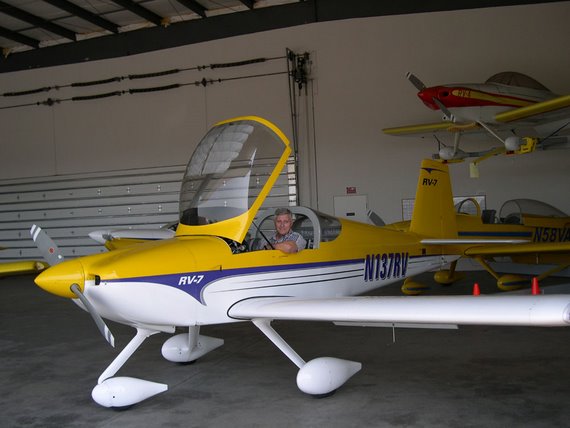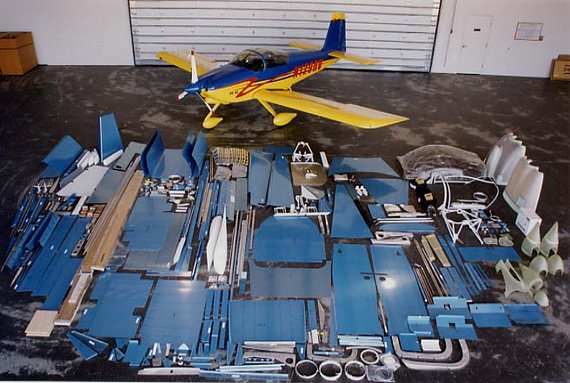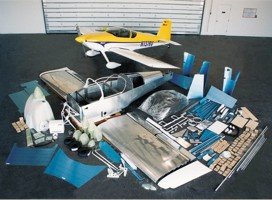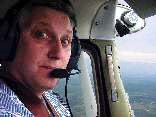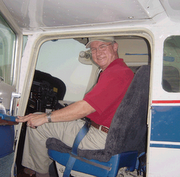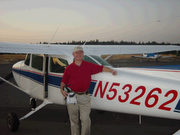Introduction - N9XG
We're building an RV9A together. The tail number is already reserved and is "N9XG"
It's the biggest project either of us has ever started. We're having a lot of fun and learning many things about airplane construction and about ourselves as well. This site is about the process, and our progress.
We will be updating this from time to time with progress reports. If you can't see enough detail in any of the pictures you can click on them and they will expand (like Magic).

Tonight we primed the gap fairings and started installing. Mostly went fine, but there are several pesky holes that will need special attention. Also need to talk to Vans about our use of pull thru rivets where bucking would be really tough.

We also mounted the left aileron to see how it fits. I think it fits great.
So last night we finished match drilling, deburring, and dimpling of the fairings and the skin on one wing. Dimpling the remaining wing will go quick and easy with the pneumatic squeezer.
Since the wings are quickbuilts there's no way to buck some of the rivets. For that reason we are thinking pull thru rivets. Need to check with Vans to see if they are structural or not. Plans call out a solid 1/8 inch rivet (AN470AD...) so we may need to use Cherry Max. Cherry Max are actually easy to use; but expensive.
Oh, we also measured and cut the aileron push rods (again). This time I'm pretty sure the lengths are correct. Vans makes you conjure the length to cut rather than just calling it out for you. I don't know why, but instead of treating it like the other push rods you have to cut, the length they give you is from the center of the end rod bearing to the center of the other end rod bearing. That removes all doubt as to what the finished length needs to be, but leaves you to measure the parts and calculate how long the steel tube needs to be.

Tonight we cleaned the gap fairings and then match drilled them. Most of the time was spent cleaning and deburring the parts. The fairings are made of thin aluminum and so we had to be careful to avoid bending them.
In this picture you can see them all clecoed into place.
The match drilling entailed two different size holes; 3/32 and 1/8th inch. I had forgotten how much fun it is to work with clecoes.


Last night we were fortunate that Paul came by with his Cleveland squeezer. The pneumatic squeezer couldn't get in to do a straight pull. It's called the 'Main Squeeze' and can use the yokes I have for my pneumatic squeezer. Anyway, we finished attaching the aileron attach brackets. (it's about time)
The new shop lights are so bright that the can lights now look kinda puny.
We did some brainstorming about the wingtips and the lights they'll contain. I think we have a pretty good plan for how it will go together.
Started cleaning the shop and putting things away. So much so, that after a while I had room on the bench to work on parts. It sure is nice to have a clean place to work.
So I started fabricating some of the parts for behind the panel. I know I'm working out of sequence, but I figure if I keep moving ahead the effort will have a cumulative affect of getting finished. I would like to be ready for the engine this summer. That means I have to keep making progress and not screw up too many parts along the way. This business of buying extra parts gets old real fast. It's not like this is a cheap project to begin with.
After I got clarity on the aileron bell cranks and got them installed, it occurred to me that I had not installed the servo for the auto pilot. So I will need to back up and get it right. Gee this is humbling stuff. I read so many builder sites and they strike me as some kinda brilliant. Oh well, we just keep building...
The Process
Most of us think of the airframe as the main thing, and I suppose it is; since you can't fly without it. The kits that Vans sells are match hole punched. That means that the holes are already located and punched when you get them. This saves a lot of time as you can imagine. So what follows is what you do once you've unpacked and inventoried the parts from the factory.
There are several thousands of these planes flying. Rather than making mistakes first-hand, I recommend looking at the web sites of builders who have already done this. Some of my favorite links are provided. You should also look at Van's 'Links' page for the model you're building.
Before touching the parts, it is advisable to read the instructions and review the drawings until you have a clear idea what needs to happen and what sequence it needs to happen in. The drawings are invaluable.
Each sub assembly requires the same basic process:
1. Prepare the parts for fitting. This entails cleaning, filing, and finally scotchbrighting. In addition, some parts require fabrication and/or machining.
2. Fitting is done numerous times. The pre-punched holes are matched to the corresponding part(s) and are held together with clecos.
3. Match drilling is done in assembly to provide optimum fit.
4. Once the holes are match drilled to the proper sizes, the part is disassembled and deburred to remove any sharp edges and irregularities that might result in a poor fit or the development of a crack.
5. Rivets that will be flush with the skin require either a dimple or countersinking. This is normally obvious, but sometimes the rivet needs to be flush and it's not clear at first glance just why.
6. At this point, a coat of primer and (in some cases) paint is applied protect the metal from corrosion. We've decided to prime and paint all skeletal parts; i.e. Spars, Ribs, etc. Skins will be primed where they connect. The method to our madness is this; we want defects to appear first in the skin where they are easiest to fix and pose less of a threat.
7. This is a dangerous part of the process because you might want to rivet something. But WAIT! Review the plans and the directions again.
8. Okay, so you've reviewed the plans and the parts are ready to assemble. Double and triple check the plans to ensure that the proper rivets are used. It's easy to mess this up or get out of sequence.
Rivets and Riveting
There are thousands of rivets that hold the plane together. Since this is an important task, let's talk a bit about them.
The rivets we'll be using are made of aluminium and are set in one of several ways; Hammering, Squeezing, Pull through.
Hammering a rivet is best done with a partner. One person operates the rivet gun and the other holds a bucking bar on the back side to create a shop head. I've tried doing this alone and almost always with undesirable results. The idea is for the shop head to be approx 1.5 times the diameter of the shank of the rivet.
Squeezing a rivet requires a special tool and is my preferred way whenever possible. Some folks use a manual squeezer, but I like pneumatic squeezer. They develop approx 3,000 pounds of force in the last 1/8th inch of the piston's travel. So proper adjustment is important. Once adjusted properly it will deliver consistent rivet sets.
Pull through (aka Blind or Pop) rivets are for those applications where there is no way to get access to the back side of the rivet. In general this type of rivet has inferior strength characteristics compared to a solid rivet. The noteworthy exception is the Cherry Max rivet. It is a pull through rivet, but it is also structurally rated and not cheap.
Removal
When rivets are set badly (as is sometimes the case) You need to decide if it's so bad that it just has to be replaced or is it okay as is. The main concern is to remove the offending rivet without doing damage to the hole it's in; e.g. enlarging or elongating or both.
If it just doesn't pass muster, get a drill bit about the diameter of the rivet shaft or smaller. Center punch the head of the rivet (solid rivets only) and then carefully drill thru the head just down to where the shaft meets the hole. Once this is done, insert and old drill bit into the hole and wiggle the head until it snaps off. Once the head is off you should be able to push it out with a punch.
With pull through rivets this can be problematic, as the shaft is most likely steel and may turn with the drill bit. Another problem with removing blind rivets is this. Blind rivets are used because access to the back side is either difficult or impossible. Onc you commit to removing the blind rivet, you have to figure out how to remove the back side when you punch it thru the hole.





